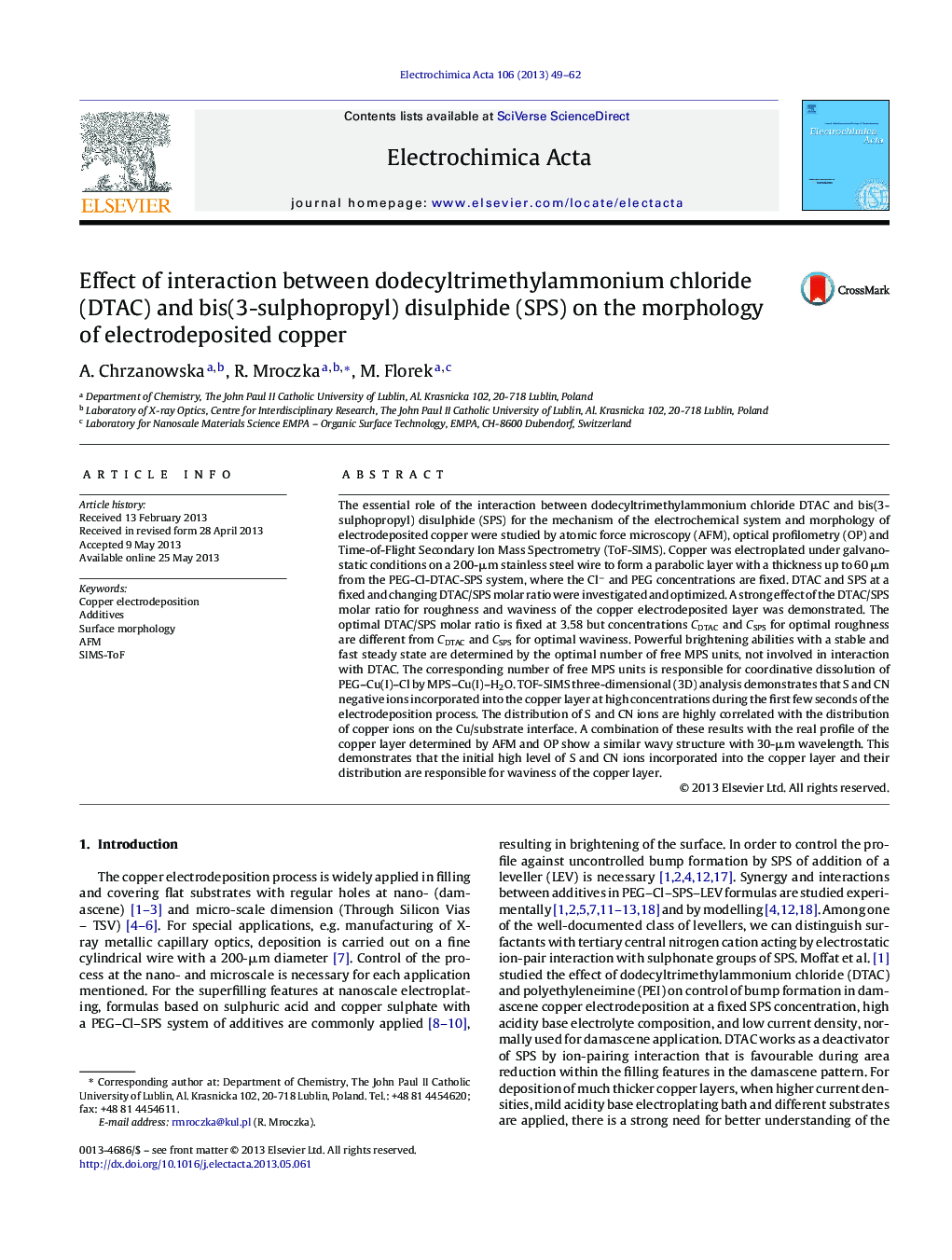| کد مقاله | کد نشریه | سال انتشار | مقاله انگلیسی | نسخه تمام متن |
|---|---|---|---|---|
| 6616724 | 459629 | 2013 | 14 صفحه PDF | دانلود رایگان |
عنوان انگلیسی مقاله ISI
Effect of interaction between dodecyltrimethylammonium chloride (DTAC) and bis(3-sulphopropyl) disulphide (SPS) on the morphology of electrodeposited copper
دانلود مقاله + سفارش ترجمه
دانلود مقاله ISI انگلیسی
رایگان برای ایرانیان
کلمات کلیدی
موضوعات مرتبط
مهندسی و علوم پایه
مهندسی شیمی
مهندسی شیمی (عمومی)
پیش نمایش صفحه اول مقاله

چکیده انگلیسی
The essential role of the interaction between dodecyltrimethylammonium chloride DTAC and bis(3-sulphopropyl) disulphide (SPS) for the mechanism of the electrochemical system and morphology of electrodeposited copper were studied by atomic force microscopy (AFM), optical profilometry (OP) and Time-of-Flight Secondary Ion Mass Spectrometry (ToF-SIMS). Copper was electroplated under galvanostatic conditions on a 200-μm stainless steel wire to form a parabolic layer with a thickness up to 60 μm from the PEG-Cl-DTAC-SPS system, where the Clâ and PEG concentrations are fixed. DTAC and SPS at a fixed and changing DTAC/SPS molar ratio were investigated and optimized. A strong effect of the DTAC/SPS molar ratio for roughness and waviness of the copper electrodeposited layer was demonstrated. The optimal DTAC/SPS molar ratio is fixed at 3.58 but concentrations CDTAC and CSPS for optimal roughness are different from CDTAC and CSPS for optimal waviness. Powerful brightening abilities with a stable and fast steady state are determined by the optimal number of free MPS units, not involved in interaction with DTAC. The corresponding number of free MPS units is responsible for coordinative dissolution of PEG-Cu(I)-Cl by MPS-Cu(I)-H2O. TOF-SIMS three-dimensional (3D) analysis demonstrates that S and CN negative ions incorporated into the copper layer at high concentrations during the first few seconds of the electrodeposition process. The distribution of S and CN ions are highly correlated with the distribution of copper ions on the Cu/substrate interface. A combination of these results with the real profile of the copper layer determined by AFM and OP show a similar wavy structure with 30-μm wavelength. This demonstrates that the initial high level of S and CN ions incorporated into the copper layer and their distribution are responsible for waviness of the copper layer.
ناشر
Database: Elsevier - ScienceDirect (ساینس دایرکت)
Journal: Electrochimica Acta - Volume 106, 1 September 2013, Pages 49-62
Journal: Electrochimica Acta - Volume 106, 1 September 2013, Pages 49-62
نویسندگان
A. Chrzanowska, R. Mroczka, M. Florek,